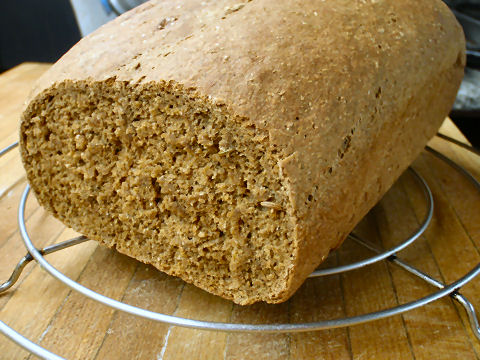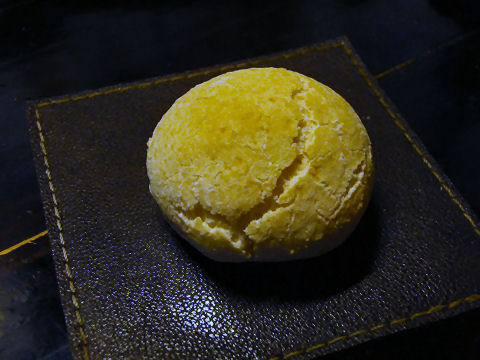“If thou tastest a crust of bread, thou tastest all the stars and all the heavens.”
– Robert Browning, poet
As always, playing around with new breads.

Nothing quite like good pumpernickel rye. Fairly classic recipe with a couple of minor adjustments:
1⅛ to 1¼ cups warm water
25 grams fresh yeast
1½ tablespoons corn oil
⅓ cup molasses
2 teaspoons salt
1½ cups bread flour
1 cup rye flour
1 cup whole wheat flour
3 tablespoons gluten
3 tablespoons bitter cocoa powder
1 tablespoon caraway seeds
Crumble the yeast into about 1 cup of the warm water and let proof for five minutes. Add the remaining ingredients and mix. Add more water as needed to bring it together in a ball. Knead for 5 minutes until relatively smooth. Let rise, covered, in a warm place until doubled in bulk (if you want to develop the flavor more intensely, let rise in the refrigerator overnight. Punch down, knead for 30 seconds and place in a standard loaf pan. Let rise until doubled again. Bake at 400°F/200°C for approximately 35-40 minutes until the bread sounds hollow when thumped on.

The chipa of Paraguay, or pão de queijo of Brazil is one of our favorite little addictive snacks. A gluten-free cheese bread puff – a basic batch makes about three dozen and we have trouble making them last overnight…. I’ve experimented with different cheeses (and in the end, less cheese, it was just too much in the original recipe I learned), and just recently, with the addition of roasted garlic, and finally have a cheesy garlic bread that really ought to put The Olive Garden out of business. Hmmm, maybe I shouldn’t post the recipe, they might steal it….
500 grams manioc starch (yuca, cassava, mandioca…)
100 grams of cold butter, cut in small bits
90 grams of Pecorino Romano cheese, grated
1 head of garlic, roasted and the pulp mashed
2 large eggs
200 milliliters of whole milk
1 teaspoon salt
Combine the starch and butter and with your fingers work it through (okay, it’s a weird feeling, I have to admit, handling manioc starch, like cornstarch, tends to send shivers up my spine) until you have a sort of sandy consistency. Add in the remaining ingredients and mix well to form a soft dough (add the milk a bit at a time so that the mixture doesn’t become too soft, it should hold together and not be too sticky). Roll out into small balls, about the size of a walnut and place on a non-stick baking sheet. Bake at 400°F/200°C for approximately 15 minutes until puffed and browned (they’ll end up about the size of a ping-pong ball). Try to resist eating long enough to get them to the table.
I should point out that the “chipá” is not exclusively Paraguayan or Brazilian (pão de queijo), but a staple food from the “Gran Chaco”, including Argentina and Bolivia also. As a matter of fact, the “chipá” is very popular and widely consumed in the provinces of Misiones, Corrientes, Chaco and Formosa. And the Paraguayan version I know (not the tastiest version of this, in my opinion) is different from the one you mention here, since it is made with anise seeds and is toroidal in shape (i.e. it looks like a donut). Best.
Yes, but given the history of Argentina and its wholesale slaughter of its own indigenous population, most of the “indigenous” (primarily Guarani) population that’s up in those regions came from over the border, bringing their cuisine with them. There are various versions of chipas – and, as noted, this version is my own recipe after playing with it a bit.
I just wonder where did you get the concept that Argentina “slaughtered” its own indigenous population, Guarani or otherwise. That has no foundation in fact! Which are the sources that support such a claim?
It doesn’t take much effort to read history books and documents of Argentina from the Spanish and British colonial period beginning in the 1500s on through the early years of the country’s formation to find accounts by not only historians, but documentation by some of the nation’s earliest leaders of their campaigns against the indigenous populations. Many of them proudly boast of the number of natives they killed or had killed on their behalf. There were wholesale expeditions just for that purpose led by some of the revered leaders of this country. Roca’s infamous Conquista del desierto from 1878 to 1884, Rosas in 1833 exterminating whole tribes in the Cuyo area, the Battle of Quera in 1875, the Popper Expedition to wipe out the Ona in the 1890s, even smaller campaigns in the last century, such as the Napalpi Massacre in 1924 by the Argentine police against the Toba people in Chaco province. Other campaigns were launched to drive tribes out of the country into Chile, Bolivia, Paraguay and Brasil. One could make a much longer list without much effort.
Try reading Héctor Hugo Trinchero’s The genocide of indigenous peoples in the formation of the Argentine Nation-State in the Journal of Genocide Research for far more detail.
Dan, thanks for the response. I am well acquainted with Argentina’s history and with the relationship between indigenous peoples (a term which is, in itself, quite arbitrary) and non-indigenous peoples. You may know that this is a field that has been fertile for recent post-Marxist revisionism in Argentina and has been -rightly- criticised as a general movement by other representatives of the left (Sebreli’s “Asedio a la modernidad” chapter on indigenism comes to mind, there are other more comprehensive and well founded critiques). Mr. Trinchero’s work responds to this particular ideological current, re interpreting facts in order to serve its own agenda. I am well aware that there have been crimes commited against indigenous peoples (Popper is a good example), but to paint Rosas and Roca’s expeditions as genocidal or to state that Argentina “exterminated” its indigenous peoples simply does not hold. Most of Argentina’s population has indigenous roots. But I will leave it here, I do not want to colonize your web site with this issue. Sorry if I went too far.
Fair enough, and of course history is always open to interpretation. I do know that there are those on both sides of the issue as to whether those campaigns were intentional genocide or had other purposes that resulted in major casualties (on both sides of the equation, no doubt). Given what I’ve read, I have to admit to leaning towards what you consider revisionism, and feel that the other point of view is the revisionist one, but that’s the way politics and history generally are – none of us was there and can only rely on our own interpretations of others’ interpretations. And, like my own country, much of what happened, happened prior to modern times, during the colonial era, and culpability can be laid at the feet of the Spanish armada of that time period, which doesn’t negate events that happened after, nor any other injustices, nor, in the same way, what has been done in the way of reparations, intermingling, etc. I don’t mind the discussion on the blog, though I suppose it’s odd that it was triggered by a bread recipe (then again, recipes and food are often at the heart of conflicts).
Yes, Argentina “slaughtered” the indigenous population the same way that the US slaughtered their own indigenous population.
Of course Maria, and I even mentioned that – so what’s your point? Virtually every country that was a colony of English, Spanish, Portuguese or Dutch occupation had the same occur. It was the way things were in the period of European empires from the 1500s on through the 1800s, often, as here and in the U.S., continuing after the colonial period had ended. Then again, it’s not all that different from going back further and looking at Roman, Greek, Ottoman, various African, even Incan occupations.
Not to derail this very interesting interchange (though from all my experience, people are tagged as ‘revisionists’ when they search to tell the untold stories that the victors have tried to erase, whether in the history of land, war, or food and culture) but I have a recipe question since those migrating chipas sound irresistable.
Manioc starch is not such a common ingredient in el Norte… Are there alternatives you’d suggest? Or from your days as NY-er, do you know where I can find it?
I agree on the revisionists!
While under the name of manioc starch this is likely hard to find in the U.S. or other northern spots, look for it as tapioca starch – it’s a common enough ingredient in puddings and such that it should be available in a good number of spots, certainly in a typical natural foods store, if not in many grocery stores, and is also a common ingredient in Chinese cooking if you live near a chinatown. If not, I’m not sure what to recommend – I haven’t experimented using other types of starches like potato or sweet potato, but my guess is they won’t work as well, tapioca has that natural “glue-i-ness” that I think this needs in order to work.
Thanks! I’ve definitely seen tapioca starch around (and an excuse to hit the Chinatown shops is never unwelcome).